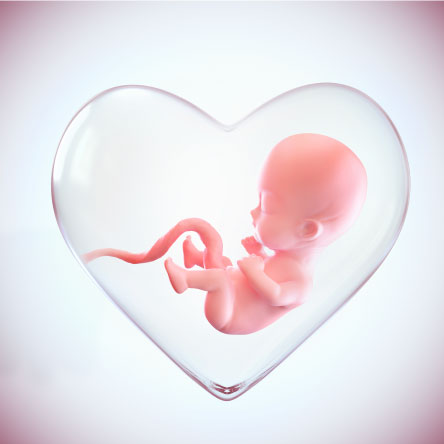Noach 5781
Whoever sheds the blood of man, by man shall his blood be shed; for man was formed in the image of God. (Bereishis 9:6)
According to R’ Yishmael, this Pasuk is the source for the Issur of abortion:
It was said in the name of R’ Yishmael that [a Ben Noach is put to death] even for [killing] fetuses. What is the reasoning of R’ Yishmael? The Pasuk states, “Shofech Dam ha’Adam ba’Adam Damo Yishafeich” [literally, “whoever spills the blood of a person inside a person, his blood shall be shed”.] Which kind of person is “inside a person”? A fetus in its mother’s uterus.
We see that a fetus is classified as an “Adam” and that it is therefore forbidden to terminate a pregnancy, as the Pasuk states “whoever spills the blood of person inside a person his blood shall be shed”. Is there any Issur in killing a fetus when it is not “inside a person”? In other words, when it is found outside of the mother’s uterus?
We refer, of course, to an embryo which is yet to be implanted in the uterus. After fertilization, the zygote divides rapidly to form a solid ball of cells known as the morula which progresses to a blastocyst by about day 5. The blastocyst has two distinct layers, the outer trophoblast layer, which will form the placenta and placental membranes, and the inner cell mass comprising embryonic stem cells. These pluripotent stem cells can become either new stem cells (self-renewal) or become specialized cells (differentiation). The scientific community has done a great deal of research involving stem cells and their possible use in understanding how diseases occur and to generate healthy cells to replace diseased ones. Embryonic stem cells come from embryos in the blastocyst stage before implantation in the uterus has occurred; removal of the cells from the blastocyst precludes the implantation of the embryo and its development into a fetus.
Although some eggs are provided by volunteer donors, and a smaller supply is produced through cloning, the majority of stem cells come from surplus IVF embryos. The standard method of in vitro fertilization (IVF) involves the removal of several eggs from the woman, then fertilizing them in a laboratory. Some are then returned to the woman’s uterus for implantation, and the others are frozen for future use or if she doesn’t conceive after the first attempt. In many instances, such as where the woman successfully conceives, or if she dies or is divorced, the frozen embryos are never used.
May one use these embryos for the production of stem cells? As stated, the production of stem cells is an irreversible process that precludes the possibility of subsequent implantation and development into a fetus, and might be considered fetocide. Is doing so Halachically permissible, especially at such an early stage of development?[1]
A Ben Noach is liable to the death penalty for killing a fetus. However, this is not true of a Jewish person who is only fined for damages. The Torah (Shemos 21) states that if a person assaults a pregnant woman and she miscarries (but the woman herself survives the attack) he must may for the damages. This indicates (as the Yad Rama, Sanhedrin 57a notes) that a Jewish person is not liable to the death penalty for killing an unborn fetus.
This principle is also discussed by the Sema. The Halacha is that a Rodef (a person pursuing somebody in order to kill him) may be killed in order to save the pursued person. Therefore, if a woman is undergoing a difficult labor and her life is in danger, it is permissible to dismember the fetus in order to save her life as it is considered to be a Rodef (Shulchan Aruch, C.M. 425:2). However, if the baby’s head has already emerged it is forbidden to kill it. The Shulchan Aruch (ibid.) explains, “We do not set aside one soul on account of another soul, and this is the nature of the world.”
This cryptic ruling is the source of great debate among the Rishonim. Why should there be any difference between an unborn fetus and one whose head has already emerged if both are endangering the mother? The Sema (ibid. 8) suggests the following approach:
“This is the nature of the world” – [the Shulchan Aruch] needed to add this point, so that one shouldn’t argue that the baby is to be considered a Rodef and they should save its mother at its expense. The Shulchan Aruch therefore added that since “this is the nature of the world”, the baby cannot be considered a Rodef.
Nevertheless, when it is still a fetus, it is permissible to kill it though it is alive. This is because when a fetus has not yet emerged into the world it does not constitute a Nefesh. The proof for this is that if a person assaults a pregnant women and she miscarries, he only needs to pay for the fetuses, and is not considered a murderer and is not subject to the death penalty.
According to the Sema, there is a fundamental Halachic distinction between a fetus and a baby that has been delivered. A fetus, though it is alive, is not considered a “Nefesh” and one is not liable to the death penalty for killing it. Once the baby is born, it is considered a Nefesh and one may not kill it even in order to save its mother. This is also the approach of Rashi and the Yad Rama in Sanhedrin (72b).
The foregoing is the basis for much of the discussion by the Gedolei haPoskim with regard to abortion. It should be noted that these sources do not directly discuss the state of development of a fetus that would preclude its abortion. However, it may be possible to derive that information from elsewhere. For instance, the Gemara in Yevamos (69b) asserts that within forty days of fertilization an embryo is considered “Maya b’Alma” (“mere water”). For this reason, a woman who miscarries within forty days of conception does not contract Tumas Leida (the impurity of birth) (Nidah 30a). Rashi (Menachos 99b) explains that before forty days the embryo has not developed any form, thus it is “Maya b’Alma”. An additional milestone is achieved when the fetus reaches the age of three months since conception. The Gemara (Nidah 8a) explains that at this stage the fetus develops a noticeable human form. The Poskim discuss whether there is any basis for permitting abortion prior to either developmental milestone of forty days or three months.[2]
An additional question is whether one may transgress any of the Mitzvos in order to save the life of a fetus. Generally, Pikuach Nefesh overrides all of the Mitzvos in the Torah, as the Torah says “va’Chai Bahem” – “and you shall live through them [Mitzva performance]” – implying that one isn’t expected to give up his life in order to fulfill a Mitzva. However, this only applies to something defined as an “Adam” – which would not include a fetus.
Nevertheless, the Gemara in Arachin (7a) rules that if a woman dies in childbirth on Shabbos, one may bring a knife (even through a Reshus haRabim) and cut through her abdominal wall to extract the fetus. The Gemara explains that doing so is permissible even though it desecrates Shabbos. Why may one override Shabbos if a fetus is not defined as an “Adam”?
The Rishonim[3] answer that although a fetus would not be included in the dictum of “va’Chai Bahem”, there is another basis for overriding the Mitzvos of the Torah in order to save lives. The Gemara in Yoma (85b) quotes R’ Shimon ben Menasia – “Chalel Alav Shabbos Achas…” – “desecrate one Shabbos on his behalf so that he will be able to fulfill many Shabbosos in the future”. Since a fetus does have the potential to observe Shabbos after it is born, one may desecrate Shabbos now in order to save its life despite it not yet being considered an “Adam”. The Ramban (Toras haAdam, Sha’ar haMeichush, Inyan haSakana) adds that this applies equally to an embryo that is fewer than forty days old as it too has the potential to observe Mitzvos in the future though currently “it has no life at all”. This is cited by several Acharonim[4]. (However, the Ramban and Ritva in Nidah 44 both stress that this has no bearing on the question of killing a fetus which depends upon its current state, and not on its future potential.)
Many of the Poskim conclude that prior to forty days after fertilization, one still cannot permit abortion unless the mother’s life (or other fetuses’ lives in the case of a complicated multiple gestation) lives are in danger. The Chavos Yair (31) explains:
If in so doing there is a destruction of a Nefesh – namely by damaging a fetus and causing its death and a miscarriage – one might have made the question dependent on several considerations: [Firstly,] whether forty days have passed since conception or not, for prior to this it is considered to be Maya b’Alma, as explained in the Gemaros in Nidah and Krisos. [Secondly,] whether three months have passed or not which is the stage that the fetus becomes recognizable as a human and when the pregnancy is externally apparent. [Thirdly,] whether the mother has felt the fetus move in her uterus or not which usually takes place a little after three months into the pregnancy… Nevertheless, it is not our intention to rule based on our own inclinations or from “Sevaros haKeres” (unfounded logic[5]) – [we] only [issue rulings] based on Torah law.
In short, the Chavos Yair could not countenance permitting abortion based on the stage of a fetus’s development. However, other Poskim[6] held that such distinctions could be drawn and ruled that a Ben Noach was not liable for performing abortions prior to forty days since conception.
Returning to the question of destroying embryos before implantation, there are several relevant distinctions from the issue of termination of pregnancy. For instance, Professor Avraham Steinberg notes that these embryos are incapable of further development unless they are implanted into a maternal host. Perhaps, in their current state, they would not have the status of a fetus even according to those who do not permit abortion at any stage.
Additionally, and perhaps more fundamentally, an embryo pre-implantation would not be included in the Drasha of “whoever spills the blood of a person inside a person, his blood shall be shed” as it is not yet “inside a person”. Therefore, there would not appear to be an Issur in destroying it.
However, it is reasonable to assume that this would still depend upon the stage of development of the embryo. If it were possible for an embryo or even a fetus to develop significantly outside of the womb, it would surely have the same status as a regular fetus and it would be forbidden to abort it even if it couldn’t be said to be “a person inside a person”.
In fact, in our essay of Parshas Tazria (5779) we discussed the possibility of fetal development outside of the actual womb. In 2017, physician-scientists at the Children’s Hospital of Philadelphia succeeded in developing an artificial womb that was tested in fetal lambs. The fetus was placed into a clear plastic bag filled with synthetic amniotic fluid and the umbilical cord connected to a machine outside of the bag that removed carbon dioxide from the blood and provided oxygen and nutrition much like the placenta does. When this technique is possible with human fetuses (e.g. in extremely premature deliveries), it will be possible for a fetus to continue developing outside of the mother’s womb.
In that essay, we debated whether the removal of the fetus from its mother’s uterus (in order to be transferred to an artificial womb) would be considered “Leidah” (Halachic birth). If so, there would certainly be no question that subsequent “abortion” would be forbidden. However, if it would not be considered Leidah, then perhaps it would still be considered a fetus which is subject to the prohibition of abortion, although is not technically “a person inside a person”, as discussed above.
[1] It is also absolutely forbidden to destroy embryos that may potentially be used by a couple in fertility treatment. Furthermore, donating sperm for the purposes of research is obviously and absolutely forbidden. This would be considered Hotza’as Zera l’Vatala and a destruction of sperm.
[2] See the Chavos Yair (31), Toras Chesed (E.H. 42), Tzitz Eliezer (7:48) Igros Moshe (C.M. 2:69) and Yabia Omer (4, E.H. 1), et. al. for further discussion that is beyond the scope of this essay.
[3] The Ran (Yoma 3b miDafei haRif) and others.
[4] See the Sha’ar haTzion 617:1. However, the Shevet haLevi (7:80) and Tzitz Eliezer (11:43) dispute this ruling.
[5] Literally, “belly opinions” or “boich sevaros” in Yiddish.
[6] See the sources cited in footnote 2 as well as the Achiezer (3:65), who discuss this matter at length.















Add comment